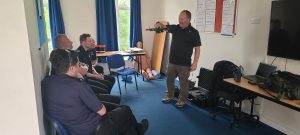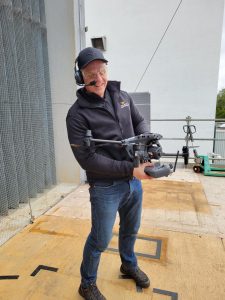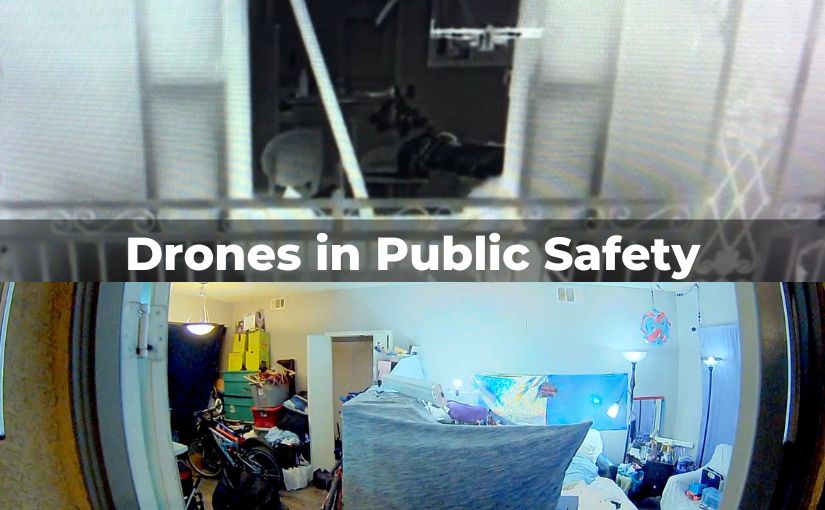When a 911 call comes in for a hostage or barricade incident, the goal is to get information about what is going on, establish contact with the suspect if possible, and end the situation peacefully. In situations like these, this has often meant sending police officers in to resolve the issue. The danger is that simply entering the scene can escalate the situation, putting hostages, suspects, and the officers at risk.
Drones are changing outcomes by reducing risk to agency members and giving commanders additional time and information to make critical decisions.

“With everything that has been going on in the last couple years, de-escalation has been a major focus for all law enforcement agencies,” explained David Martel, retired Las Vegas Metro Police (LVMPD) and director of public safety at Volatus Aerospace. “Because law enforcement can do their jobs at a safe distance, drones are changing how police officers deal with crisis negotiation, leading to even better outcomes for everyone involved.”1
Drones give an incident commander the option to gather critical information remotely and reduce the risks to officers.
Drones give an incident commander the option to gather critical information remotely and reduce the risks to officers. Like any tool, however, it’s important to understand both the capabilities and limitations of a system. Not all drone systems are right for every task. Having a thorough understanding of what a situation’s specific requirements are, is essential to selecting the correct drone for the task.
In a dynamic high-risk event, the system operator needs a high degree of both skill and critical thinking when operating these systems, which is why comprehensive training is critical.

“A good training program will not only maintain a high level of operator skills but also ensure the equipment maintains maximum operational ability,” said Andy Olesen, director of public safety at Volatus Aerospace and retired police officer of 30 years for the Halton Regional Police Service. “This technology is rapidly evolving. New systems and capabilities require a training program that can equally adapt to change.”2
Real-World Applications
The following are three real-world scenarios from Martel’s time at LVMPD that demonstrate how drones are changing how crisis situations are handled.
Barricaded in a Public Building
A man was reported to be armed with a gun at a local pharmacy and was clearly upset and incoherent. Although he let everyone leave the building and didn’t take any hostages, he had holed up in the building and was refusing to come out.
The agency sent a drone in to investigate.
We were able to see with the drone that the gun was left on the counter across the room from the suspect. We used the drone to keep him away from the gun by perching near the suspect and having a two-way conversation with him. Our negotiators were able to talk him down and reassure him that nothing was going to harm him. We were able to give him the help that he needed. If we didn’t have this technology, our usual course of action would be to send a few officers in to speak with him face-to-face to figure out what was going on, potentially escalating the situation, and putting everyone at risk.
Barricaded in a Vehicle
LVMPD got a call about an individual who had barricaded herself in a vehicle and refused to come out. The callers were concerned she might hurt herself. Instead of bringing officers up to the car and potentially agitating her even more, the agency deployed a drone.
Martel explained,
We used one aircraft to distract her and make sure she was unarmed, and then used another drone to break the glass on the passenger window. Officers were able to take her into custody without anyone getting hurt.[A drone] is a great de-escalation tool, but it is also a great distractor—peoples’ attention are drawn to it.
Barricaded in a Home
When called to a home, there are different challenges that officers face in comparison to public spaces and vehicles. For starters, it is usually a confined space with multiple rooms. There could be animals, children, and other occupants present. The state of the house can vary considerably, and there are a lot of places people can hide as in a situation Martel found himself in toward the end of his career at LVMPD.
In one of the last incidents that I flew before retiring, the suspect was hidden in the attic. The only way we knew that he was up there was that we were able to get a look with a drone from the entry in the laundry room. We perched the drone close by and was able to get a live feed to see if he would come down or not. He refused to speak to us, but we were able to hear his movements. We took our time observing him, and he eventually came out and was given instructions to leave the residence.
Situations like these examples can end tragically but being able assess the situation and react at the best possible time helps to ensure better outcomes.
Safer Outcomes
When law enforcement can place a robot in the place of a human being, they are effectively reducing the possibility of a scenario where someone gets hurt by orders of magnitude.
“Drones have been proven to bring violent situations to a calm and orderly resolution where no one is hurt—that’s our ultimate goal,” concluded Martel. “With this technology and the proper training, instantaneous life-changing decisions don’t have to be made, drones let us take our time, slow the momentum down, and let the individual make the decision on how the situation will go. At the end of the day, drones are replaceable, people aren’t.”
| Volatus Aerospace Corp. is a leading provider of integrated drone solutions throughout North America and growing into Latin America and globally. Volatus serves civil, public safety, and defense markets across a variety of applications including thermography, mapping, search and rescue, and drone as a first responder. Volatus Aerospace Co. can share lessons we have learned from our own experience in the field as well as from other law enforcement agencies around the world through our training programs, contact us to learn more. |
Notes:
1Danielle Gagne, “Drones Are Replaceable, People Aren’t: Three Real-Life Case Studies of Brinc’s Lemur S from David Martel, Ret. Las Vegas Metro Police,” Drone Network News, June 10, 2022.
2Andy Olesen (director of public safety, Volatus Aerospace, ret. police officer, Halton Regional Police Service), interview, September 22, 2022.



